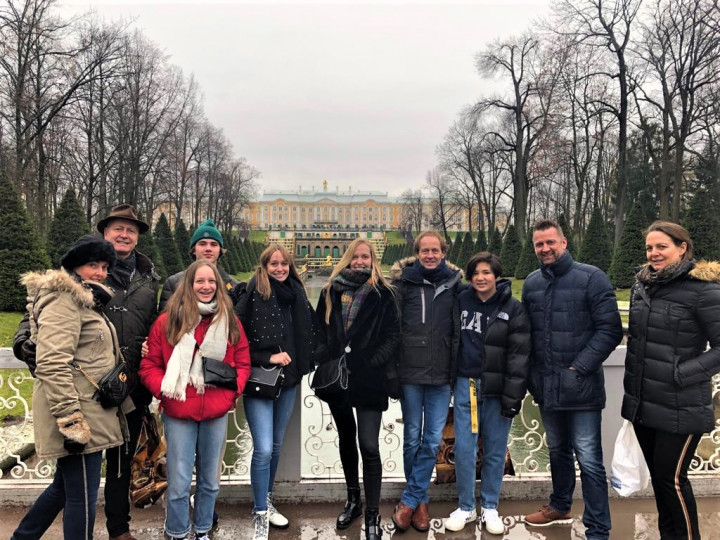I visited St petersburg for the first time twenty years ago, and immediately fell in love with this beautiful city. The city has so much cultural and historical heritage to offer that it is very easy to fill 4 days in St Petersburg. Using this overview, you will be able to visit all the main sights in four days.
4 days in St Petersburg
Before traveling to St Petersburg, read these tips for traveling to Russia.
Day 1: St Petersburg highlights
Start your journey with a tour of the city. This way you get a first overall impression and you get to know your way around a bit. The three churches and cathedrals that should not be missed during your citytrip to St Petersburg are the Church of the Savior on Blood, Saint Isaac's Cathedral and the Saints Peter and Paul Cathedral.
Take about 5 hours to view these three churches on the inside and enjoy a delicious lunch along the way.
Church of the Savior on the blood
The official name is 'Church of the Ressurection of Jesus Christ'.
This Russian Orthodox church was built exactly where Tsar Alexander II was murdered on 13 March 1881. They threw a bomb at his carriage but they missed. The Tsar got out to see what was going on, after which a second bomb was thrown which unfortunately did hit its intended target.

The Tsar's son ordered a church to be built on this site as a memorial to his father. The tower of the church is exactly 81 meters high and refers to the year in which the murder was committed.
There is a shrine inside the church, on the exact spot where the blood of Alexander II would have been.

During WWII, the church served as storage and later even as a mortuary.
The church was badly damaged during the war, and a bomb got stuck in the dome of the roof. After the war, exploding the bomb and thus destroying the church was one of the options considered. Fortunately, UNESCO put a stop to it, and this beautiful monument was preserved.
Repair works only started in 1970 and were completed in 1997. The church has been a museum ever since.
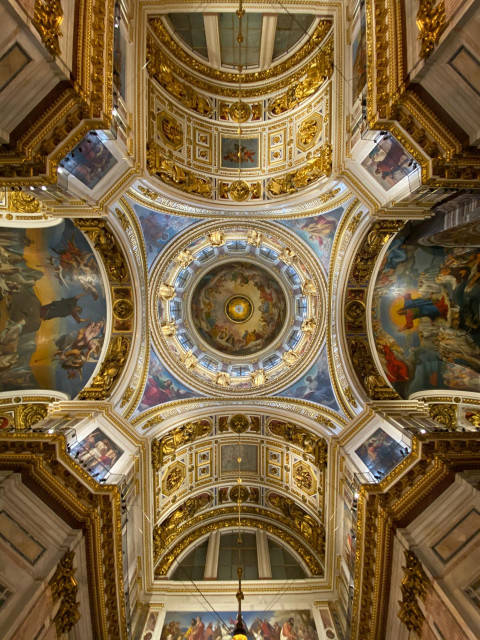


The Church of the Savior on the Blood is magnificent on the outside with its golden and coloured domes, but the inside is even more impressive.
The walls and the ceiling are covered with 7500 m² of mosaics.
The images were created by the most famous artists of the time. It means that restoring the mosaics was a real feat.

Opening hours: daily from 10.30 am – 6.00 pm. Closed on Wednesdays.
Save time and money and buy your tickets online!
There is a small altar in the church. The original was destroyed and the current one is made of papier-mâché.
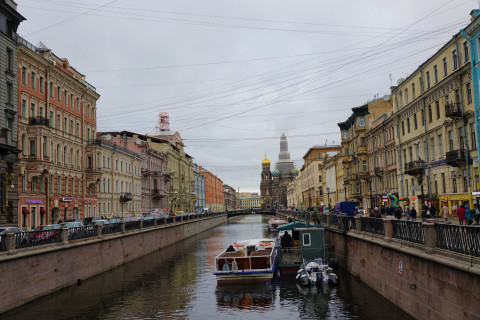
You have a great view of the church if you walk along the Nevsky Prospekt and stop at the Singer store (more or less diagonally opposite the Kazan Cathedral).
Saint Isaac's Cathedral
.A second attraction that should not be missed during your city trip to St Petersburg is this cathedral on Isaac Square.

Peter the Great had a small wooden church built here in 1707. Since that church did not suit the grandeur of the rest of the city so construction of a larger church was started in 1717. However, it wasn’t long before landslides caused cracks in the church, and a large fire eventually destroyed the church in 1735.
The Isaac Cathedral from 1818 is one of the largest cathedrals in the world and is built on more than ten thousand piles. The foundation work alone lasted 5 years and was carried out by 125,000 employees.

In the Soviet era, the cathedral was used as an atheist museum to show how much money was wasted on religion.
The red granite columns on the outside weigh 114 tonnes each, and were brought in from Finland on specially built flat-bottomed boats.

The inside of the cathedral is spectacular. Mosaics, gold-plated icons and amazing ceiling paintings. You don’t know where to look first. The painted ceiling of the central dome is incredibly beautiful and there is a silver dove in the middle of the dome symbolizing the Holy Spirit.

A beautiful stained-glass window can be seen through the doors of the gilded iconostasis.
The 20-tonne southern doors are made of oak and bronze and decorated with dozens of reliefs.


Inside the cathedral stands a bust of Auguste de Montferrand, the architect. He was very slow with the construction of the Isaac as a gypsy woman had predicted that he would die shortly after the works were finished.
The construction took 40 years and he did actually die a short time after completion.
Opening times: Every day from 10:30 am to 6:00 pm. Closed on Wednesdays.
Avoid waiting and save money. Buy your tickets online!
Other sights on Saint Isaac's Square:
- Statue of the Bronze Horseman: the rearing horse of Peter the Great tramples a snake as a symbol of the determination of the city’s founder. The statue is named after a famous poem by Pushkin. Catharine the Great had the statue made as a tribute to her husband. The artist worked on the sculpture for 12 years. The pedestal alone, made from one solid boulder of granite from the Gulf of Finland, weighs 1625 tonnes and contains the inscription “To Peter I from Catharina II”. Newlyweds often pose in front of the statue as it is said to bring good luck.
- Admiralty: The 407-meter long facade of the Admiralty building is decorated with statues and reliefs, and nymphs carrying globes stand on either side of the arch of the main entrance. The building first served as a shipyard and later as a tribute to the Russian Navy. You can see the gilded spire from afar.
- Astoria hotel and Hotel Angleterre. Both 5-star hotels are great choices for your 4 days in St Petersburg. At the time, Hitler planned his victory celebration at the Astoria Hotel.
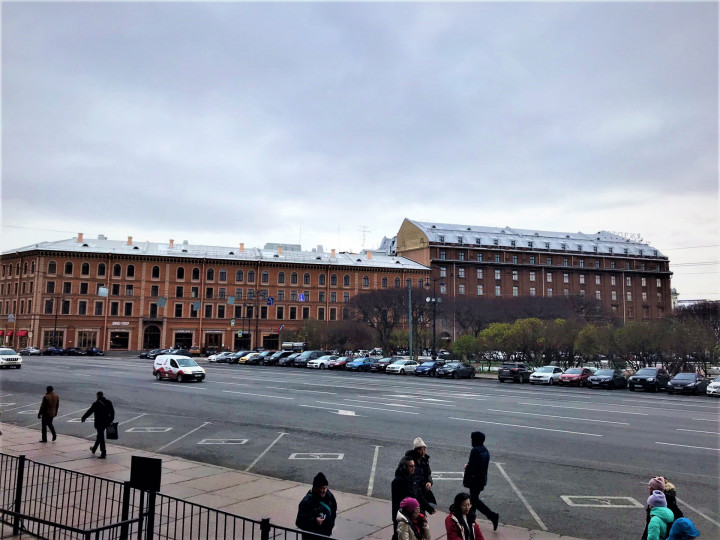

Peter and Paul Cathedral
The Saints Peter and Paul Cathedral is located inside the Peter and Paul Fortress. From the Hermitage in St Petersburg you can see the gilded spires on the other side of the Neva. On top of the 123-meter-high spire stands an angel holding a cross.

The cathedral dates back to 1733 and is located on Hare Island in the Neva River. It is part of the fortress that Peter the Great had built to protect against possible attacks during the Great Northern War. It was the first stone cathedral in St Petersburg and was named after the apostles Peter and Paul, saints in the Russian Orthodox Church.
The fortress served as a political prison between 1718 and 1924.
The impressive altar is made of wood and was painted over with gold leaf by 44 workmen.
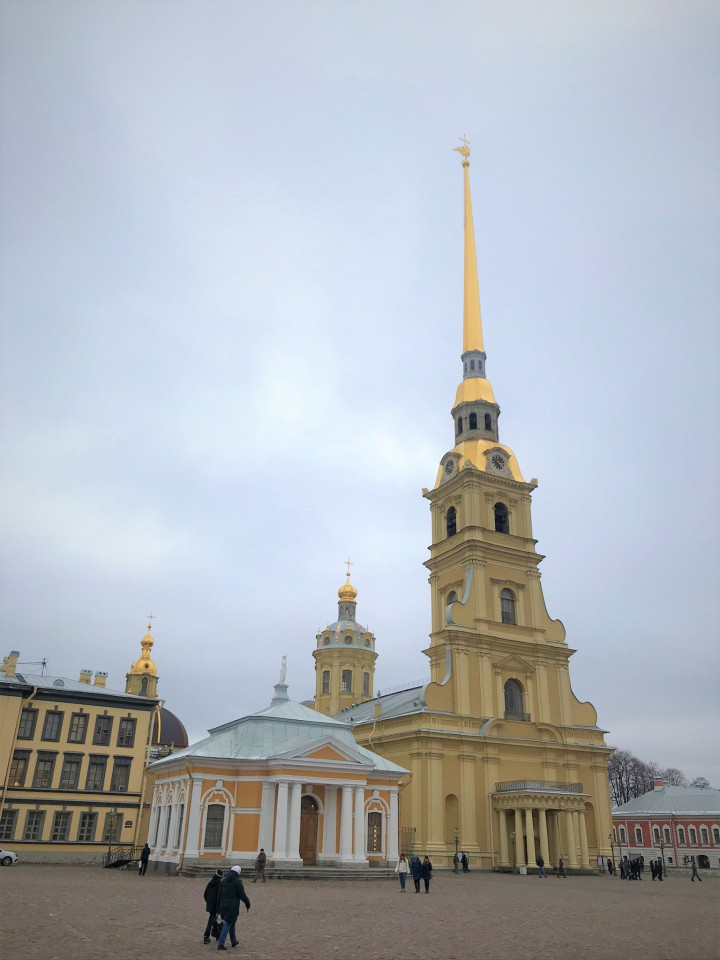
The graves of nearly all Russian rulers lie within the walls of the cathedral.
Peter the Great and his wife Catharine were laid to rest here. Catharine was a Lithuanian farmer's daughter. She was taken to St Petersburg as a war trophy and eventually found work as a laundress for a friend of Peter the Great. When he saw her, he immediately fell in love and eventually married her. She gave him 12 children of which only 2 survived.
The throne features a coat of arms with a two-headed eagle. Those two heads symbolize the fact that Russia belongs to Europe and Asia.
In the green grave lies Alexander II, who ruled over Russia from 1855 to 1881. He died in a bomb attack. The place where he died became the location for the Church of the Savior on Blood. His wife lies in the red tomb.

Alexander III succeeded Alexander II and was Tsar from 1881 to 1894. His father had given the Russian people more autonomy, but Alexander III restricted some of those freedoms because he believed that the murder of his father was a consequence of it. It meant that he was not very popular. His Danish wife was able to escape from dangerous Russia and died in Denmark. It was her wish to be buried next to her husband. Her remains were only moved here in 2006. Her husband's coffin has been here much longer and this is apparent because the gold on his coffin is much darker.

The Chapel of Saint Catherine the Martyr is a separate room in the back corner. This is where funeral services were held for children of the highest nobility. In 1998 it also became the final resting place for the last of the Romanovs and some of their loyal servants. Tsar Nicholas II and his wife and five children were exiled to Yekaterinburg during an uprising in 1917. The entire family and a few servants were executed by Bolsheviks, adherents of communism, in 1918. This is definitely one of the highlights to visit during your St Petersburg citytrip.

For a long time it was thought that Anastasia was still alive and there were doubts about the identity of the remains of 2 children. In the meantime, DNA research has shown that the bodies are indeed from the tsar and his family.
Tsar Nicholas II and his wife Alexandra first had 4 daughters. With great joy they welcomed their fifth child, a son they named Alexei. Unfortunately, their happiness was short-lived because Alexei suffered from haemophilia. Alexandra sought help from Rasputin, a faith healer. However, the people were not aware of the fact that Alexei was seriously ill. As a result, they did not understand the close relationship between Rasputin and Alexandra, which gave the latter a bad reputation.
Fun fact: the cat that walks around here is the "house cat". She has been living here for 16 years (2019).

Opening hours: every day from 10:00 am to 7:00 pm. Saturday only until 6:45 pm.
Save time & money and buy your tickets online.
Sights along the Nevski Prospekt
If you still feel like a walk after visiting these wonderful museums, take a stroll along Nevsky Prospekt, the main avenue in St Petersburg.
Peter the Great had been to Europe and he wanted to design a city that looked like Amsterdam. For Nevsky Prospekt, however, he got his inspiration from the Champs-Elysées in Paris. The avenue runs for over four kilometres from the Admiralty to the Alexander Nevsky monastery.
There are churches of all faiths along the Nevsky Prospekt, causing the French writer Dumas to call it the street of religious tolerance.
Some sights along the Nevsky Prospekt:
- House number 120 has a sign with the words “Citizens! This side of the street is the most dangerous during artillery bombardments.”
- The Literary Cafe at number 18 was Pushkin’s favourite. He left from here to his fatal duel in 1837. Pushkin is one of the greatest poets in world literature, and together with Tolstoy and Dostoevsky, among others, he belongs to the golden age of Russian literature. Pushkin was happily married to Natalia but he was very jealous. At one point he thought Natalia was in a relationship with Georges d’Anthès and he challenged him to a duel. Unfortunately, he lost and he died of his injuries two days later.
- The Kazan Cathedral is the largest monument along the Nevsky Prospekt. It was built to preserve the icon of the Madonna of Kazan. The Madonna of Kazan, found in Kazan in 1579, is the most revered icon in the Russian Orthodox Church. The architects of the Kazan Cathedral were inspired by the Saint Peter's Basilica in Vatican City.
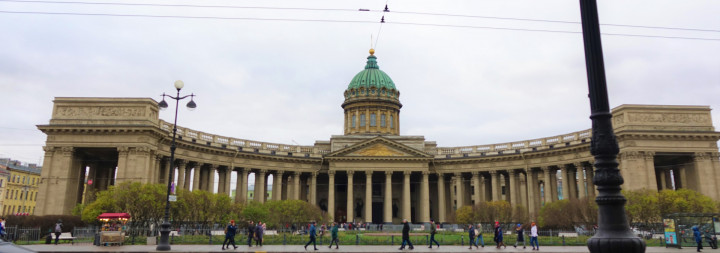
- .Diagonally opposite the Kazan Cathedral is a beautiful building where Singer (the well-known sewing machine brand) is housed. From here you have a wonderful view of the Church of the Savior on Blood.
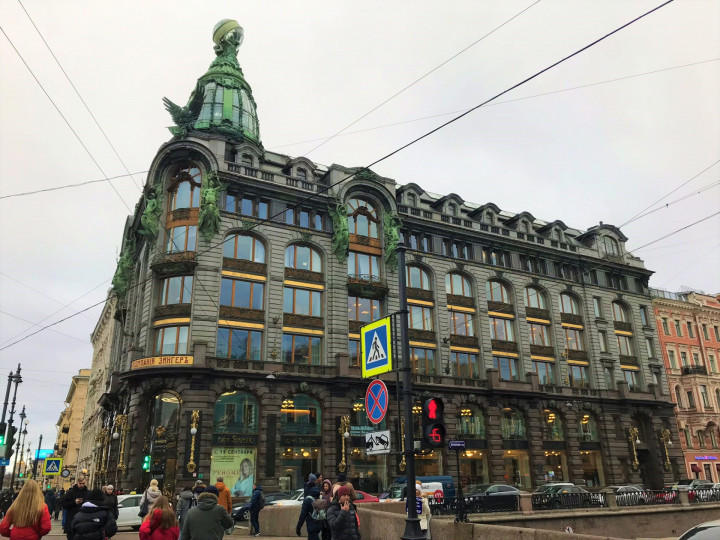
- Number 56 is the address of Magazin Kuptsov Yeliseyevykh. Russia's oldest deli shop is located in this insanely beautiful and historic building. When I visited the store 20 years ago, it was still quite authentic and not as richly filled as it is today. Today it is a tourist attraction, but very impressive nonetheless. The store is luxuriously furnished and is the ideal place to score a nice souvenir. Do you want to avoid the crowds? Then book a table in the evening at their restaurant SKLAD No 5 or Mezzanine. You have to go through the store. At that time, it is closed which means you can look around at your leisure. You can also come here during the day for a cup of coffee with cake.
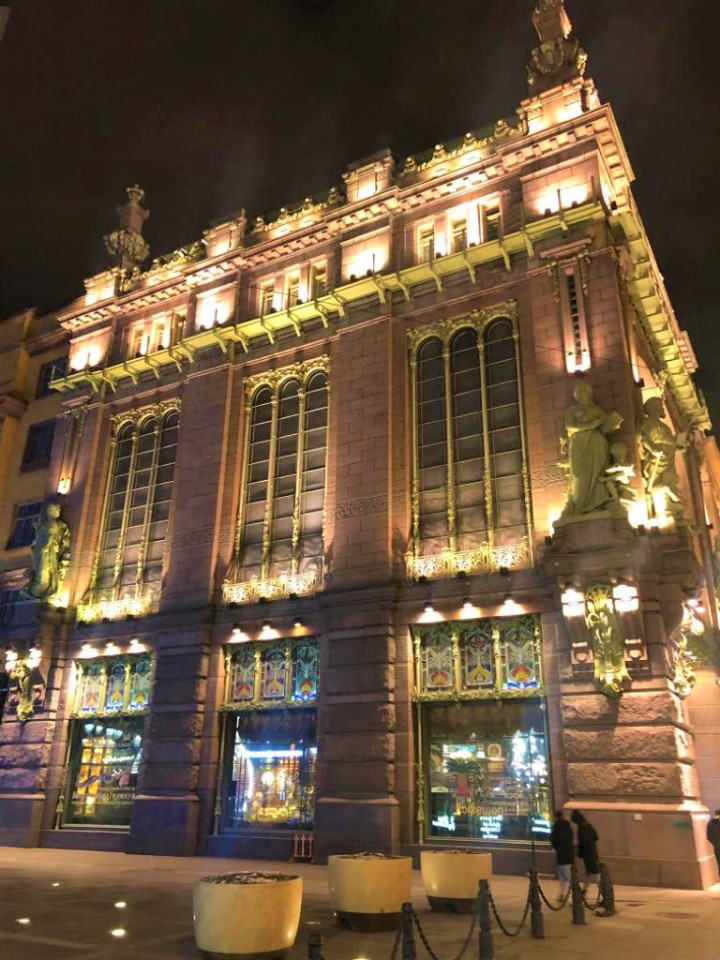
- You can recognize the Anichkov bridge across the Fontanka river by the four beautiful statues of horse tamers.
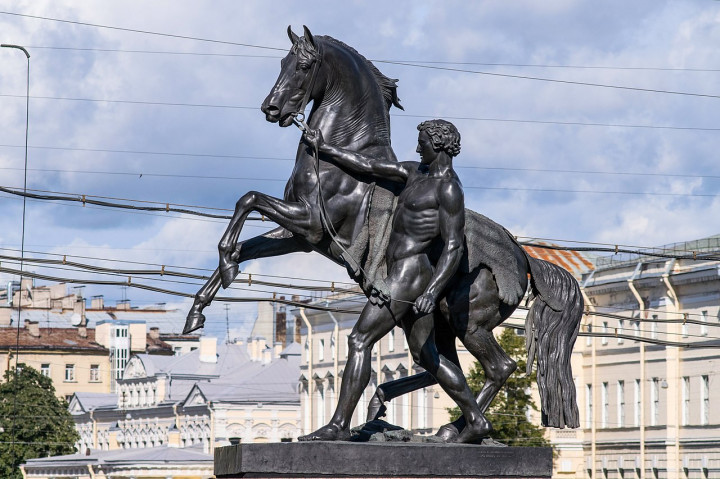
Ballet
The Russian ballet is world famous so your 4 days in St Petersburg are not complete without a night of ballet.
The most famous theatre in St Petersburg is the Mariinsky. We enjoyed a performance of the Swan Lake here 20 years ago. The Mariinsky I is the old, historic theatre. As soon as you go inside, you imagine yourself in a bygone era. Red velvet chairs and wall coverings and golden, richly decorated balconies. A visit Mariinsky I is worth it, even just to see the interior. The current building dates back to 1860 and is home to the Kirov Ballet with 100 opera singers and singers, more than 70 dancers and dancers and a symphonical orchestra.
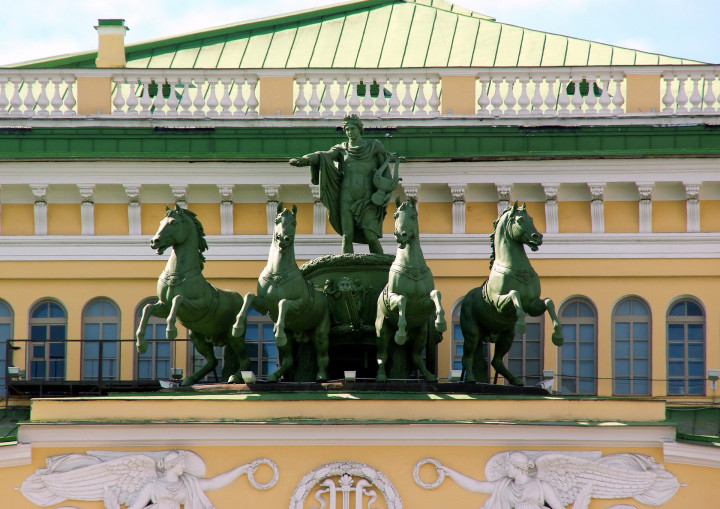
This time we booked tickets to see the Cinderella ballet in the new theatre, Mariinsky II. This hyper-modern theatre is the cream of the crop. It is of course less charming than Mariinsky I, but then again it has great acoustics. We had seats in the first row and looked straight into the orchestra pit. Very special and we were occasionally somewhat distracted by the very exuberant conductor.
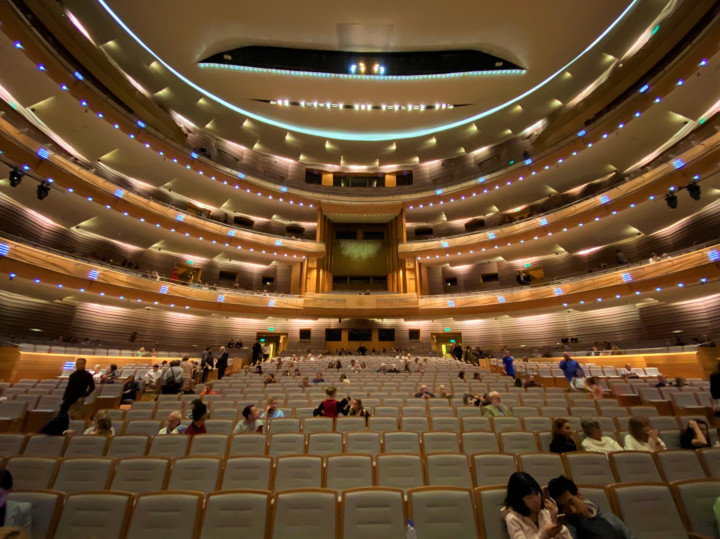
DAY 2: Hermitage St Petersburg
Day 2 of your 4 days in St Petersburg is all about the most famous landmark: Hermitage St Petersburg
Visit the Hermitage
The Hermitage is the best of the best for art and museum lovers, but even if you are not a fan, you still have to go here. The building itself is already a sight to behold. It's one of if not the St Petersburg highlight.

The Winter Palace is the most impressive building of the most famous museum. Catharine the Great started her limited collection of works of art in 1764 but soon had to expand the Hermitage to accommodate her 2,500 paintings, 10,000 sculptures and as many drawings. Her enormous collection of silver and porcelain could also fill a few palaces.
If you stand on the other side of the Neva you have a wonderful view of the façade of the Hermitage with, from right to left, the Winter Palace, the Pavilion Hall, the Great Hermitage, the Winter Canal, and the Theatre.
The impressive entrance hall of the Hermitage is amazing. The Jordan staircase dates to 1762 and was designed by Rastrelli. From this viewpoint, the imperial family could watch the annual baptismal ceremony in the Neva


But you will also linger in the following rooms:
- State Rooms: at the time, these rooms symbolized the power and wealth of Russia.
- Pavilion Hall: this fabulous white marble and golden room replaced Catharine’s original interior, and is now the home of the Peacock Clock. One of the most extraordinary assets of the Hermitage.
- The amazing golden Chapel





Before you go, find out what there is to see in the Hermitage and decide which collections you absolutely want to see. Because seeing everything is out of the question. You will need 11 years if you want to view each piece of art for 1 minute.
And be sure to buy your tickets in advance too, as the queues can be endless. During the high season, giant cruise ships pass by and all the passengers want to visit the Hermitage. It is also very busy at the weekend. So try planning your visit on a weekday or do what we did and travel in off-season.
Palace square
At the rear of the Hermitage lies the Palace Square. Standing tall in the centre of this square is the Alexander Column, in honour of Tsar Alexander I, for his victory over Napoleon. The inscription on the column reads "To Alexander I, from a grateful Russia. The 47-meter high column weighs more than 600 tonnes, making it the largest triumphal comumn in the world.
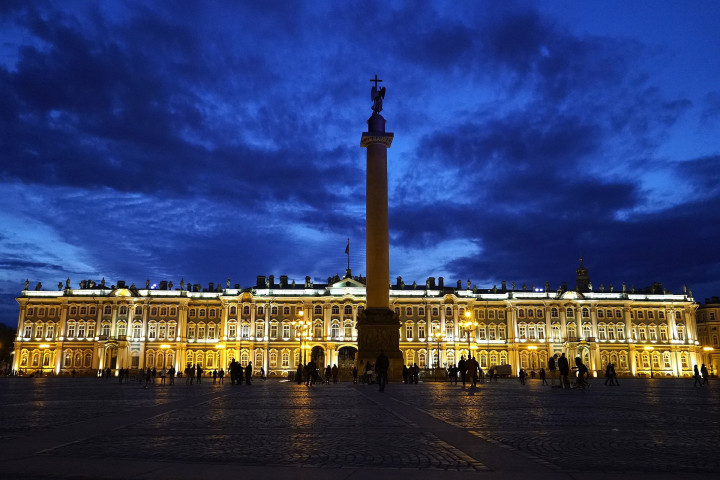
Foto credit: Dvorianova via Pixabay
Other buildings around the square are the Winter Palace, the headquarters of the Russian army, a triumphal arch, the Guards Corps Headquarters and the Admiralty.
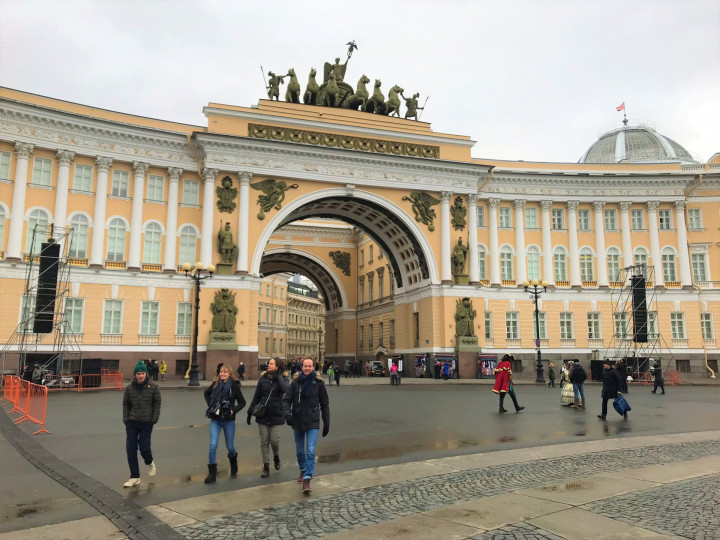
Palace Square has played an important role throughout Russian history and the 1905 Bloody Sunday also took place here. On the fateful Sunday, the tsar's troops opened fire on thousands of unarmed protesters who wanted to present a petition to Tsar Nicholas II. This massacre marked the start of the Revolution.
Shopping in St Petersburg
- If you would like to go shopping, visit the largest department store in St Petersburg: Gostiny Dvor.
- There is an interesting shopping arcade diagonally across from Gostiny Dvor, housed in a historic gallery with a glass roof.
- Go to MDT (Maker Design Loft) for expensive designer brands. This store is located on a side street of the Nevsky Prospekt. Restaurant "Biblioteka" is located on the corner of the street, and is also recommended. There is a wonderful caviar shop between the restaurant and MDT.
It is not very interesting to go shopping in Russia. Items of clothing are more expensive than at home because they have to pay high import duties here.
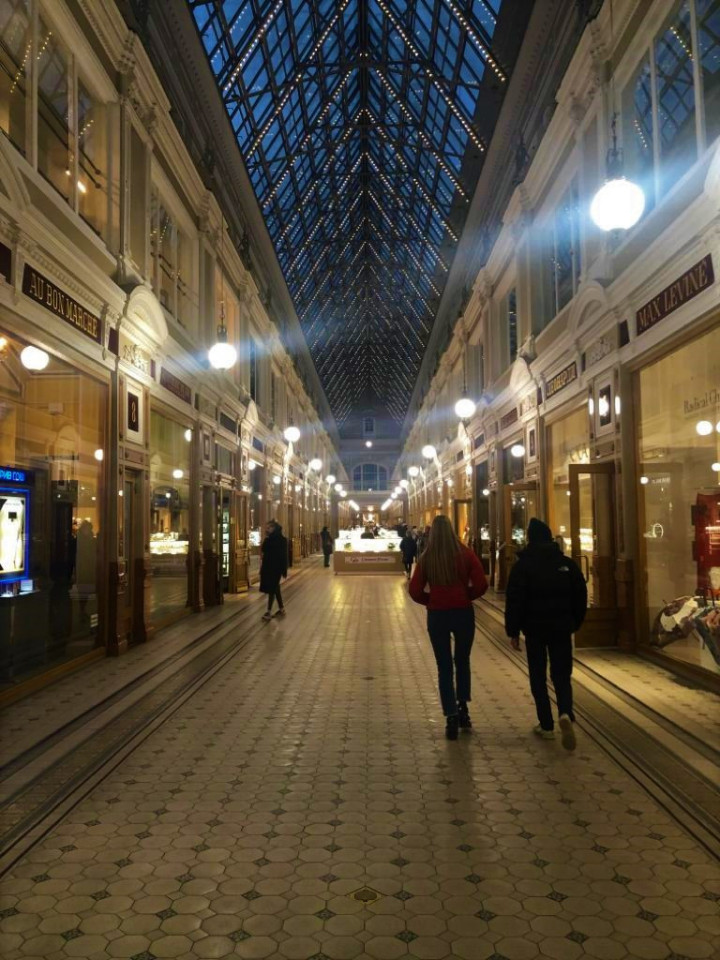
DAY 3: Pushkin
The third day we were picked up at our hotel at 10 am for the St Petersburg Winter Fairy Tale Horse Ride & Tour.
First, a minibus brought us to Pushkin, 20 kilometres southeast of St Petersburg, to visit the former summer house of the Romanovs.
The town was founded in 1710 by Peter the Great who named it Selo, and it soon it was nicknamed "Tsar Village". In 1937, on the centenary of Pushkin's death, the city was renamed Pushkin and it is a UNESCO World Heritage Site. There are two beautiful palaces in this city.
Pavlovsk Palace
The Pavlovsk palace was built for the son of Catharine the Great. This circular palace is located in one of the largest parks in Europe.

During the 2nd World War the palace was occupied by the Nazis for 28 months. Fortunately, many works of art and furniture had been removed and hidden beforehand, but the Nazis completely destroyed the castle.
Pavlovsk was the first palace to be restored after the war. At first people thought it was a lost cause, but a 27-year-old museum director came with a plan and proved that it was possible to restore the palace to all its glory. She found artists who were able to restore the majestic wall and ceiling paintings.
The outside of the castle is not very spectacular, but the inside is beautiful. The beautiful rooms, libraries, tapestries and party rooms are all equally impressive.
Be sure to stop at the painting of Cupid. Wherever you are in the room, it always appears as though Cupid is looking into your eyes and pointing his arrow at your heart. If you visit this room, love is sure to find you. We had a bachelor with us and after our visit his Tinder account got really popular







Catherina Palace
.It is only a short walk from Pavlovsk to the Catharine Palace. On the way there you pass by the house where Nikolai Mikhailovich Karamzin, a famous Russian writer, lived between 1816 and 1821.

.Shortly afterwards you will see the golden, shining towers of the Catherine Palace.
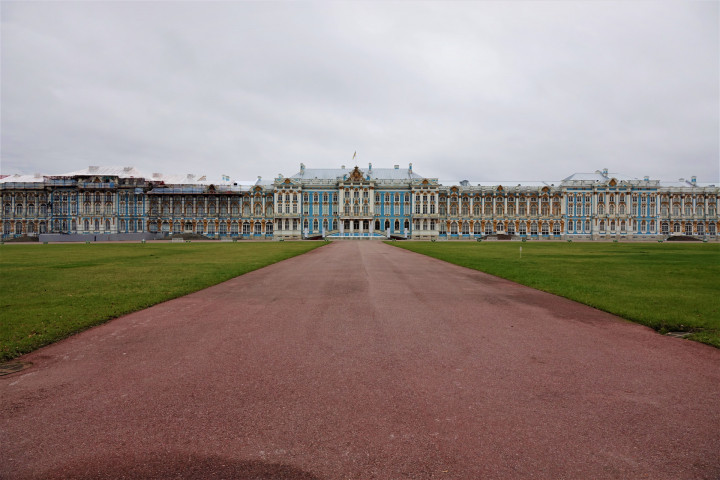
Amber Room
This blue and white palace was deliberately destroyed by the Nazis during the 2nd World War. Fortunately, they had removed and hidden all valuable paintings and furniture from here on time too. Only the Amber room could not be brought to safety. The Nazis stole the room, and it has never been recovered.
The amber panels were last seen in Königsberg, later Kaliningrad. Since there was heavy fighting there, there is a chance that the panels, which are very flammable, went up in flames. Yet the Russian Government is still investigating the missing Amber Room. During their search they managed to recover a stone mosaic and a dresser that once stood in the Amber room.
The most popular theory is that the amber panels are in a train with countless other treasures, and it is said to be hidden in a mine at Walbrzych. Numerous research teams and treasure hunters have been searching for this train for years, without success.
The Amber Room has been reconstructed but it is not the original version. The palace is visited en masse by the Chinese because they believe that touching the amber brings good luck.
The amber wall plates were originally made for the King in Prussia. However, he presented it as a gift to Peter the Great. Tsarina Elisabeth commissioned the architect Rastrelli to install the amber wall plates at Catherine Palace.
However, Catharine the Great did not like the building’s Rococo style. She had a small house built in Greek Revival style in the garden where she spent her days.
We did not have enough time to go into the Catherine Palace this time. Instead we had a pleasant trip with horse and carriage through the park and nearby forest.

Vodka and Caviar tasting
Russia is known for its vodka and caviar. A citytrip to St Petersburg is not complete without a Vodka and Caviar tasting.
We went to Russian Vodka Room No. 1. First, we were given a tour of the small museum. There we learned, among other things, that drinking shots was introduced by Peter the Great. He hated it when people arrived late and therefore introduced the rule that everyone who arrived late should drink a glass of vodka ad fundum. However, the glass in question was a bit larger than the current shot glasses. The person who was most drunk received a medal.


Although the Russians are still avid vodka drinkers, only 2 of the 40 distilleries are left.


During the prohibition, people started distilling their own alcohol. A rubber glove was placed on the bottle they used, and when the drink was ready, the glove would fill with gas. They placed the bottle in the front window of their house. When they came home and saw that the glove was up, there’d be a party as the drink was ready.
The museum is home to different types of special bottles, including bottles with a knot at the top for people who want to stop drinking. The crooked bottles are for the seasoned drinkers, as after a few drinks, the bottle would automatically look straight.
After the short tour (by a very boring guide) it was time for the tasting. We got to taste four types of vodka. A standard vodka, one with garlic, one with oats and one with honey. And we also tasted pancakes with sour cream and caviar. Delicious!
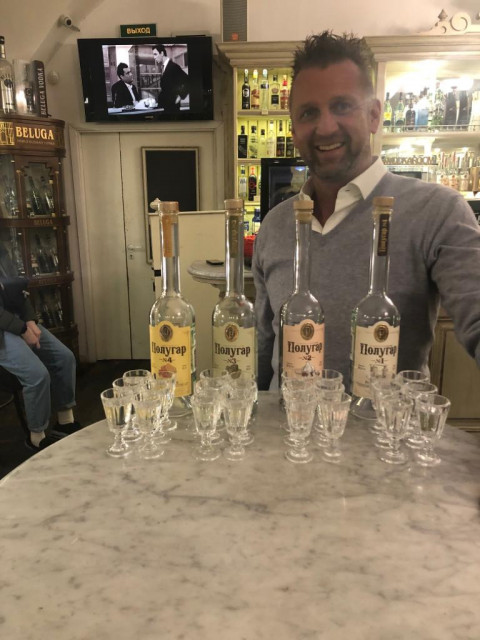

DAY 4: Peterhof Palace
During the last of our four days in St Petersburg, we had just enough time to visit another important landmark.
Ten years ago we travelled to the Peterhof Palace by hydrofoil, a boat that flies over the water. This time we took the car.
After the victory over Sweden, Peter the Great wanted to build a castle that was "suitable for the greatest of the princes." After his trip to Europe, he was fascinated by Amsterdam, but he also got a lot of inspiration in France. His ambitions for his castle were fuelled by his visit to Versailles. He wanted a Russian version that had to become even bigger, more impressive and flashier than the original, and he succeeded quite well. Construction started in 1714. Peter the Great moved into the imperial residence in 1723. In the meantime, construction continued, but the works stopped when he died in 1725.
Tsarina Elisabeth I had an extra floor and 2 large side wings added. Her architect, Rastrelli, did not foresee as many fountains as Peter the Great, but all the fountains that Peter the Great had planned were installed at a later stage.
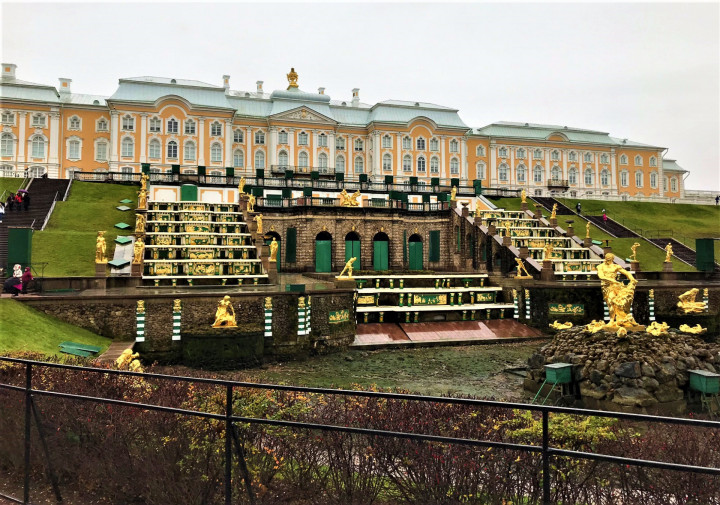
The main staircase is one of the most impressive parts of the palace. The gilt carvings and the ceiling fresco are true works of art.
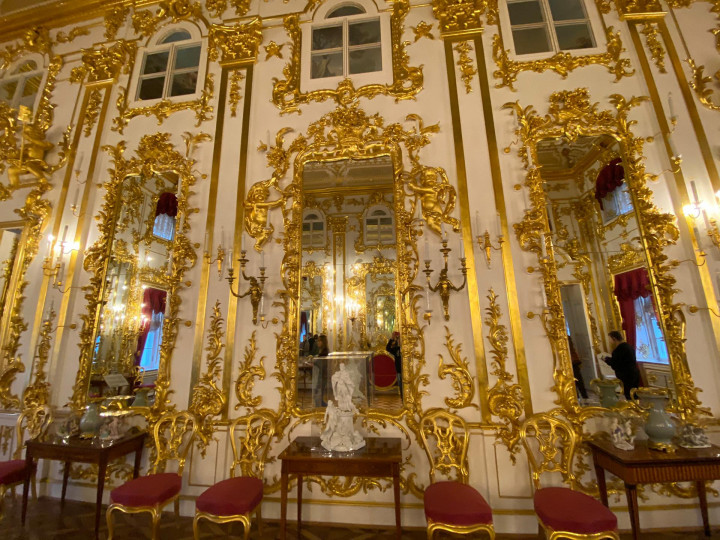
Peterhof Palace became state property during the Russian Revolution. As was the case in many other palaces, the artworks and furniture were removed and hidden. Peterhof Palace became a museum in 1918. During the 2nd World War every effort was made once again to save the artworks, and many valuables were buried. Peterhof Palace was occupied from 1941 to 1944 and the palace and gardens were badly damaged. Fortunately, the restoration work started quickly.
The palace complex is situated on a 16-meter high cliff on the Gulf of Finland, less than 100 meters from the coast A canal runs from the coast to the palace allowing Peter the Great to sail right up to his front door. At the end of the canal lies the Grand Cascade with a total of 37 bronze statues, 64 fountains, and 142 gargoyles. The Samson Fountain was destroyed during the war so the current fountain is a reproduction. The golden statue of Samson opening the mouth of a lion is most powerful fountain at the Peterhof Palace.
